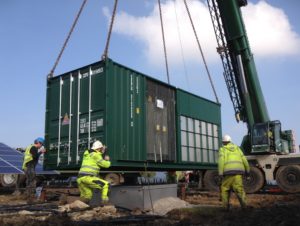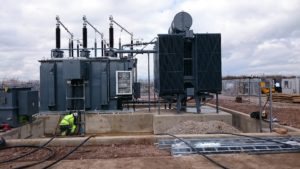Lessons to be learnt
An investigation is set to follow Friday’s widespread power cut which will no doubt shed further light on what happened, why it happened, and the impact of the resulting shut down of sections of the high voltage network.
A key area of attention will be what happened after the system failed. National Grid has said that the systems worked well, power was restored within 15 minutes, and steps were taken to maintain power for the bulk of the country and to protect assets. National Grid, however, acknowledge that this resulted in a loss of service for a million customers, and that the knock-on impacts for distribution network operators and to get transport services back up and running took a lot longer to resolve.
My own personal impact was not being able to buy a cup of coffee on Totnes High Street, a GDP loss of approximately £1.90. Far better than my last big black-out in Manhattan, 2012, during Hurricane Sandy – holiday pretty much ruined!
We will find out more once the review has been published but it seems that areas of the high voltage network were automatically taken offline – including power for transport and other critical services. It sounds like National Grid pulled the levers that it could but in hindsight this proved to be a pretty blunt response that involved knocking out trains and traffic lights. In response National Grid’s CEO, John Pettigrew, has agreed to look at shut-down prioritisation within the system.
It’s right that questions are being asked. The energy system of the future ought to be smarter than this. Could more integration and coordination between the transmission and distribution networks have allowed for a more surgical response; pulling power from less critical parts of the distribution network while maintaining essential services? Shouldn’t transport and other key services not have a more resilient back-up power supply? Operators of critical infrastructure must surely anticipate the possibility of a power cut and share some of the responsibility.
The value of fast-response assets like batteries

One thing we can say right now is that the power cut demonstrated the importance of highly responsive assets that can kick in to maintain frequency and capacity while other generation assets, such as gas fired power stations, can be brought on line. Regen has said before[1] that the first 15-30 mins of an unexpected event, of the type we had on Friday, are critical. This is an ideal role for battery electricity storage.
This event could rekindle the debate about the 2017 decision to de-rate battery storage in the Capacity Market. This was done because batteries may lack the duration to see-out a 4 hour capacity stress event, but de-rating was done without finding a way to recognise the value of having highly responsive assets that could provide power within seconds or milliseconds of an unplanned outage.
Of course, it could be argued that the Capacity Market serves a different purpose. It is about maintaining an overall capacity margin, by enabling low utilisation assets to stay in business (it’s a subsidy for fossil fuels in other words) and to ensure that assets are on hand to meet the requirements of a stress event – provided the stress event obliges by giving 4 hours’ notice. We have previously described this form of energy security as comparable to the French Maginot Line before WWII, fine in a big set piece battle but not much use in the blitzkrieg of an unexpected outage.
Friday’s events may lead to a rethink. National Grid ESO has already contracted battery storage assets to provide frequency response services and has revamped the way these services are procured to create a more open market, but clearly whatever contracts were in place were insufficient to meet the, admittedly rare, event of a double shutdown.
There is a trade-off here. As a rule of thumb ESOs would normally have sufficient frequency response on standby at any moment to cover the unplanned shut down of the largest plant in operation. Having more response assets available would of course cost money, paid for by the consumer, and the National Grid ESO has been under increasing pressure to reduce balancing service costs. The two assets that dropped out were reportedly generating at a combined capacity of over 1.4 GW[2]. That’s a pretty big hole to fill. On the plus side, increased competition in the frequency response market has reduced these service costs by over 60% in the last two years. So contracting additional frequency support services to act as a buffer has become significantly cheaper.
Unblocking the storage development pipeline
 The very frustrating thing is that, according to BEIS’s own Renewable Energy Planning Database[3], there are over 150 battery storage projects, totalling over 3.3 GW of power capacity with planning and mostly with grid connections, that are stuck in the development pipeline “awaiting construction”. The UK claims to be leading the world in smart energy and battery storage but at the moment only a few projects are making progress. In fact, there are currently only three projects listed as “under construction” and two of those have been listed at this status for over 18 months.
The very frustrating thing is that, according to BEIS’s own Renewable Energy Planning Database[3], there are over 150 battery storage projects, totalling over 3.3 GW of power capacity with planning and mostly with grid connections, that are stuck in the development pipeline “awaiting construction”. The UK claims to be leading the world in smart energy and battery storage but at the moment only a few projects are making progress. In fact, there are currently only three projects listed as “under construction” and two of those have been listed at this status for over 18 months.
The reason these projects are not currently being built is largely due to uncertainty over future revenue streams and the challenge of raising finance. That uncertainty has been exacerbated by policy changes initiated by BEIS and Ofgem to, for example, to de-rate storage in the capacity market, change the basis on which network charges are calculated and generally to reduce the revenue making opportunities of decentralised (embedded) assets in the energy system. The result of these changes has been to favour larger, mainly transmission connected assets, such as OCGT gas fired power stations. It is ironic that, just when we need more smart flexible assets, the energy system is shifting to favour older and less responsive technology.
Looking ahead, a short term step might be to run another frequency response auction of the type National Grid ran in 2016[4] offering 4 year contracts to specifically bring forward new storage capacity. Given the backlog of projects currently seeking finance such an auction would be extremely competitive and would represent an excellent investment for future system resilience.
Rethinking energy security
In the longer term, the UK needs to reconsider what we mean by energy security. Speed of response, flexibility and diversity ought to be of much more value to the energy system of the future, alongside scale and duration. If the Capacity Market’s more general purpose is to provide a revenue stream for assets that we want to see built in order to provide future services to the system, then it would make sense to consider all asset capabilities not just capacity.
This could mean reshaping the Capacity Market, or perhaps running a parallel process to support assets providing response and flexibility.
Better integration and coordination between the transmission and distribution networks is needed; allowing DSR, generation and storage assets connected to the distribution network to play a bigger role. It is also clear that shut-down prioritisation needs to be better managed.
New technology may also be able to address these issues to create more resilient systems. A lot of work is being done to look at how inertia (stability) can be maintained in a system with much more renewable energy. For example, wind and solar farms could be incentivised to provide their own “synthetic” inertia, while the island of Ireland energy system has been leading the way to develop super-fast “digital inertia” using battery storage assets.[5]
Lots to think about and hopefully lessons will be learnt. It’s certainly not a good thing that the system was disrupted, but one positive outcome would be for policy makers to wake up to the energy security benefits of fast responsive assets. The focus at the moment may be on National Grid ESO, but government and policy makers need to do more to proactively support the transition to a smarter, secure, net zero carbon energy system. Regen and the Electricity Storage Network will continue to make this point.
Regen is a not for profit centre of energy expertise and market insight whose mission is to transform the world’s energy systems for a low carbon future.
The ESN was established in 2008 as the UK industry group dedicated to electricity storage. It includes a broad range of electricity storage technologies and members, such as electricity storage manufacturers and suppliers, developers of projects, users, electricity network operators, consultants, academic institutions, and research organisations.
The ESN is managed by Regen.

[1] Regen Capacity Market https://www.regen.co.uk/capacity-market-for-a-renewable-future-call-for-evidence/
[2] Little Barford gas-fired power station, in Bedfordshire reported at 660 MW and Hornsea 1B at 790 MW. Note National Grid has stated that high winds and wind variability were NOT the cause of either shutdown.
[3] BEIS Renewable Energy Planning Database
[4] Enhanced Frequency Response Auction (Aug 2016) secured over 200 MW of frequency response services with 4 years contracts
[5] as outlined in a new report by Everose using Queens University Belfast data. https://info.fluenceenergy.com/everoze-report-digital-inertia-ireland-island

 Regen’s director,
Regen’s director,